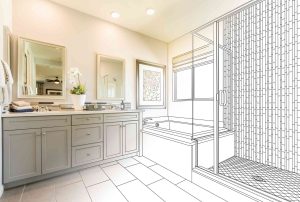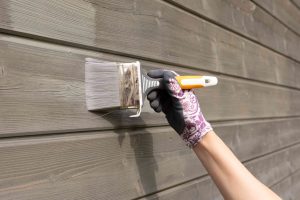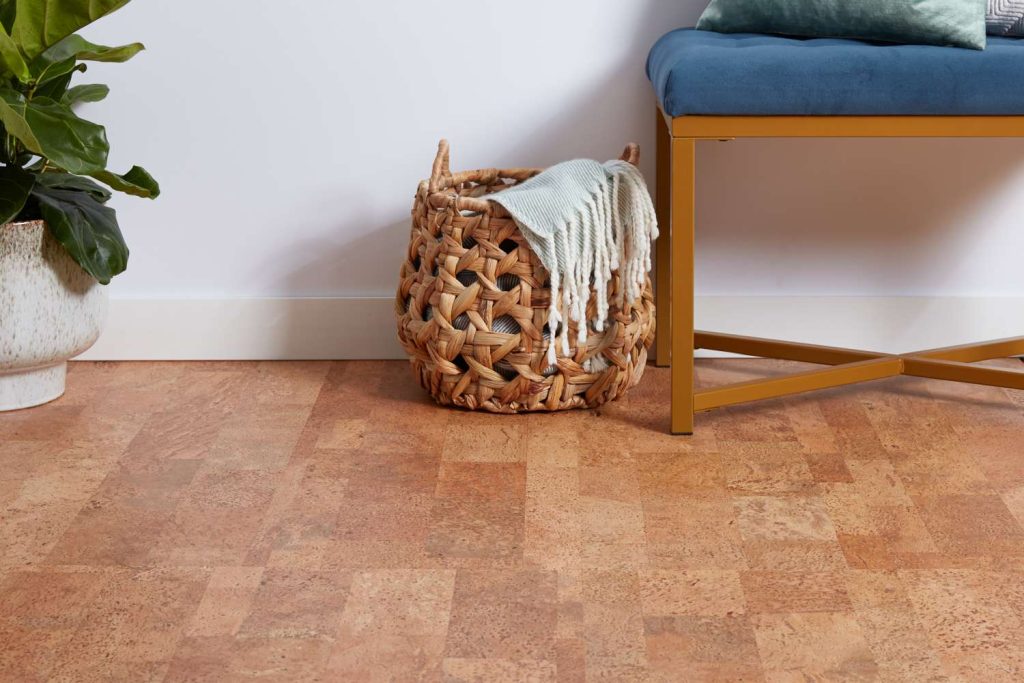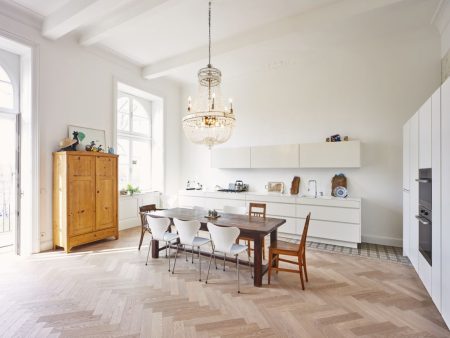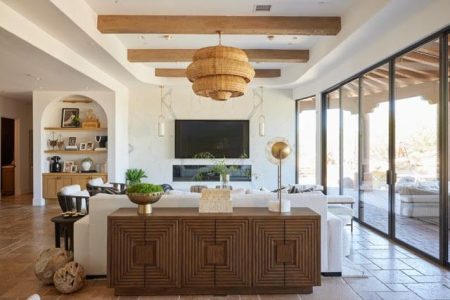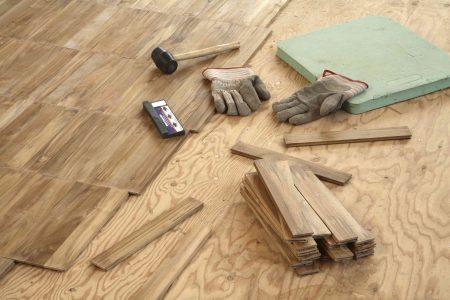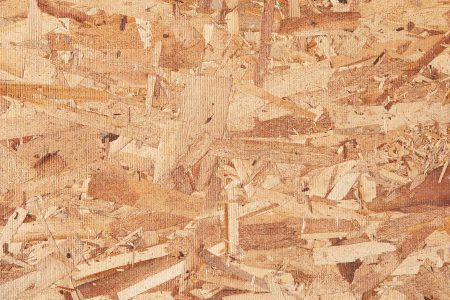Although cork flooring has been around for many decades, it has recently come into vogue in a major way, due to the fact that it is a “green” renewable resource that can be used without the guilt associated with using fine hardwoods from old-growth forests or tropical rainforests.
What Is Cork Flooring?
Cork comes from the bark of the cork oak tree (Quercus suber) and is periodically harvested from the living trees in plantations planted for commercial purposes. Cork is, therefore, a completely natural, recurring, and easily replenishable material. To create flooring products, cork is ground up, compressed, and formed into sheets bonded with resins.
Cork is also biodegradable and will break down into the environment at the end of its life cycle.
Cork flooring has many merits, to be sure, and its trendy popularity has led to cork installation almost everywhere in the home. But this flooring is not as durable as some other flooring materials, and it is susceptible to several forms of damage. It is important to understand the underlying characteristics of cork in order to make an informed decision on using it in a specific space.
Cork Flooring Costs
Costs for cork flooring planks or tiles can run from $2 to $12 per square foot, depending on the thickness of the material, the quality of the cork, and the quality of the finish. Professional installation is fairly economical, adding about $2 per square foot. Nationally, the average cost for covering a 100-square foot room with cork flooring is about $950—or $9.50 per square foot. This is comparable to what a bamboo floor costs, and slightly less than most hardwood flooring. But unlike hardwood or bamboo, installing cork flooring is a fairly easy DIY project, allowing many homeowners to save on professional installation costs.
Maintenance and Repair
When installed correctly with multiple layers of a quality sealer applied to the surface, cork flooring is relatively simple to take care of. It requires only regular sweeping or vacuuming to remove small grit and dirt particles, and damp mopping every so often. But it is important that spills are wiped up immediately to prevent staining. The finishing process involves sealing cork in order to create an invisible barrier over its surface, and this offers some protection against water stains and damage. The seal coat needs to be renewed periodically. However, sealers are not perfect, and if a room is flooded, cork flooring can warp and discolor. High humidity can also cause the cork to curl or plump, which may lead to tiles to pop out or planks to buckle.
Cat and dog nail scratches are a particular problem with cork flooring. Keeping their nails trimmed can help this, but pets will invariably damage a cork floor. If you have very heavy appliances or furniture pieces, they can sometimes cause permanent divots in the material. This can be offset to some extent by using furniture coasters and placing larger pieces on flat wooden boards or other support pieces.
If direct sunlight beams down on a cork floor every day, then discoloration may occur and a patch of the floor can end up taking on a different hue than surrounding areas. This can be prevented by blocking sunlight with curtains or blinds, but it will require constant vigilance and care.
One of the best things about a cork floor is that you can refinish its surface periodically, just as you can with hardwood, to give it a fresh new look. This involves sanding the solid cork tiles or planks down past the point of any imperfections, and then staining and or re-applying the finish sealer to the surface. This can be done several times, depending on the thickness of the material. Refinishing is not possible, however, on engineered cork flooring, where the surface cork layer is relatively thin.
Prepare for your next flooring project with a pro
You don’t have to go at it alone! Find and compare quotes from top-rated professionals near you.
Get a Quote
Design
Traditional cork flooring has a warm, natural look that works best in spaces with an informal, casual decor. However, newer manufacturing techniques have created cork floors that closely resemble hardwood, marble, or even concrete. Today’s cork flooring can now be used almost anywhere, provided it is kept well sealed. As with vinyl tiles, a skilled installer can create almost limitless looks by using different colors to create custom designs. Be aware that cork floors will eventually show wear from small scratches and dings, and they are best suited for spaces where this antique patina will be welcome.
Watch Now: The Pros and Cons of Cork Floor
Cork Flooring Installation
Cork flooring is available in several different forms, made from either slices of cork or from granulated cork mixed with resin binders. The flooring material can be solid cork throughout the thickness or laminated around a fiberboard core. The traditional cork flooring consists of solid cork tiles that are applied to the floor with glue-down applications, much the way vinyl tiles are installed. Another newer form of cork flooring is laminated planks, which consist of a bottom layer of compressed cork, then a core of medium-density fiberboard (MDF) or high-density fiberboard, then a top layer of top-quality cork. Cork planks are usually assembled with lock-lock edges for a floating floor installation, similar to how laminate flooring or luxury vinyl planks are installed. Floating floors are generally installed over a thin foam underlayment pad.
If the cork flooring is not prefinished, the last step is to coat the installed floor with several layers of sealer.
Installing cork flooring is a relatively easy DIY project, which gives cork some advantage over solid hardwood or bamboo flooring, both of which can be tricky for DIYers.
Top Brands of Cork Flooring
Cork flooring can be purchased economically at most major big-box home improvement stores, but for the best selection, check out the offerings at specialty flooring stores. Here are some of the major suppliers of cork flooring:
- Globus Cork Flooring: This company ships products from its NY factory. It currently offers cork tiles in more than 38 colors in 34 different sizes.
- WE Cork: WE Cork sells several lines of tiles and planks in assorted sizes and styles. There are numerous shades of floating and glue-down flooring products.
- iCork Floor: iCork Floor is a factory-direct distributor of cork products. It sells directly to consumers through its web site, with very economical pricing on both floating and glue-down tiles and planks.
- APC Cork: This is a leading supplier of cork flooring across North America. It offers several lines of floating and glue-down tiles and planks, in 87 styles. APC Cork is available through a network of specialty flooring stores.
- Heritage Mill: This is the brand of cork flooring sold in Home Depot stores, which currently has two different types of floating plank cork products at prices ranging from $1.99 to $3.09 per square foot.
Comfort and Convenience
One of the best things about cork is how soft and yielding it feels beneath your feet. Because of this, cork is popular in rooms where you will be standing for long periods of time, such as kitchens. The soft surface can also provide a cushion when someone accidentally trips and falls, making it a great choice for children’s rooms and for older residents prone to falling.
Cork contains a waxy substance called suberin. This material has the property of naturally repelling insects. This makes cork floors resistant to the growth and colonization of these organisms and can help to promote the healthfulness of an environment.
Inside, cork is made up of millions of tiny air-filled chambers that act as barriers against noise transmission, effectively insulating any room. The same property helps cork flooring save you money on heating and cooling bills. Cork is also great for sound deadening, making it an excellent pick for noisy rooms.
Cork vs. Bamboo
Cork flooring is very often chosen because it is a renewable resource, unlike hardwood, in which trees are killed during the harvest. If this virtue is important to you, another material to consider is bamboo flooring. Bamboo is made from the fibers of the bamboo grass plant, which continues to grow after the stalks are cut. While bamboo flooring has a different look than cork, both materials are recognizably different than hardwood flooring, and both give your floor a unique appeal. The main advantage that bamboo has over cork is that it is a much harder material, giving it better resistance to scratches and dents. But bamboo will not have the soft resilient feel underfoot that is offered by cork, nor does it have the sound and thermal insulation properties that cork does.
Is Cork Flooring Right for You?
Cork is a good choice if you’re looking for a warm, attractive flooring material that has a comfortable, informal appearance. It is not the right flooring material if you insist on a perfectly pristine floor, as cork is a somewhat soft material that develops a patina of wear over time.
Read the full article here



